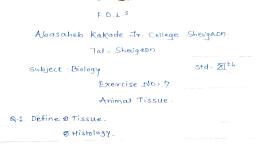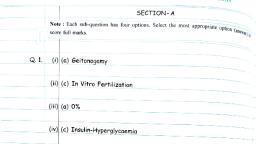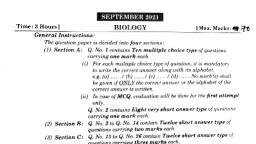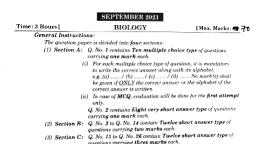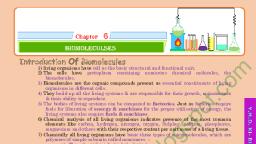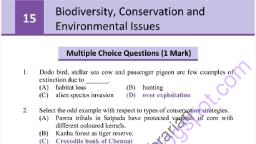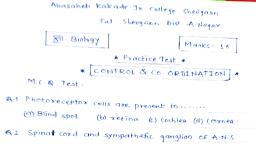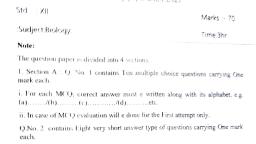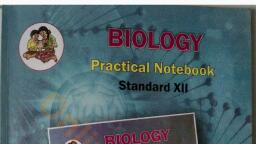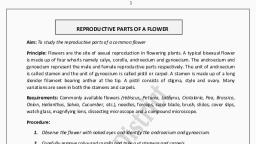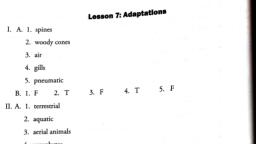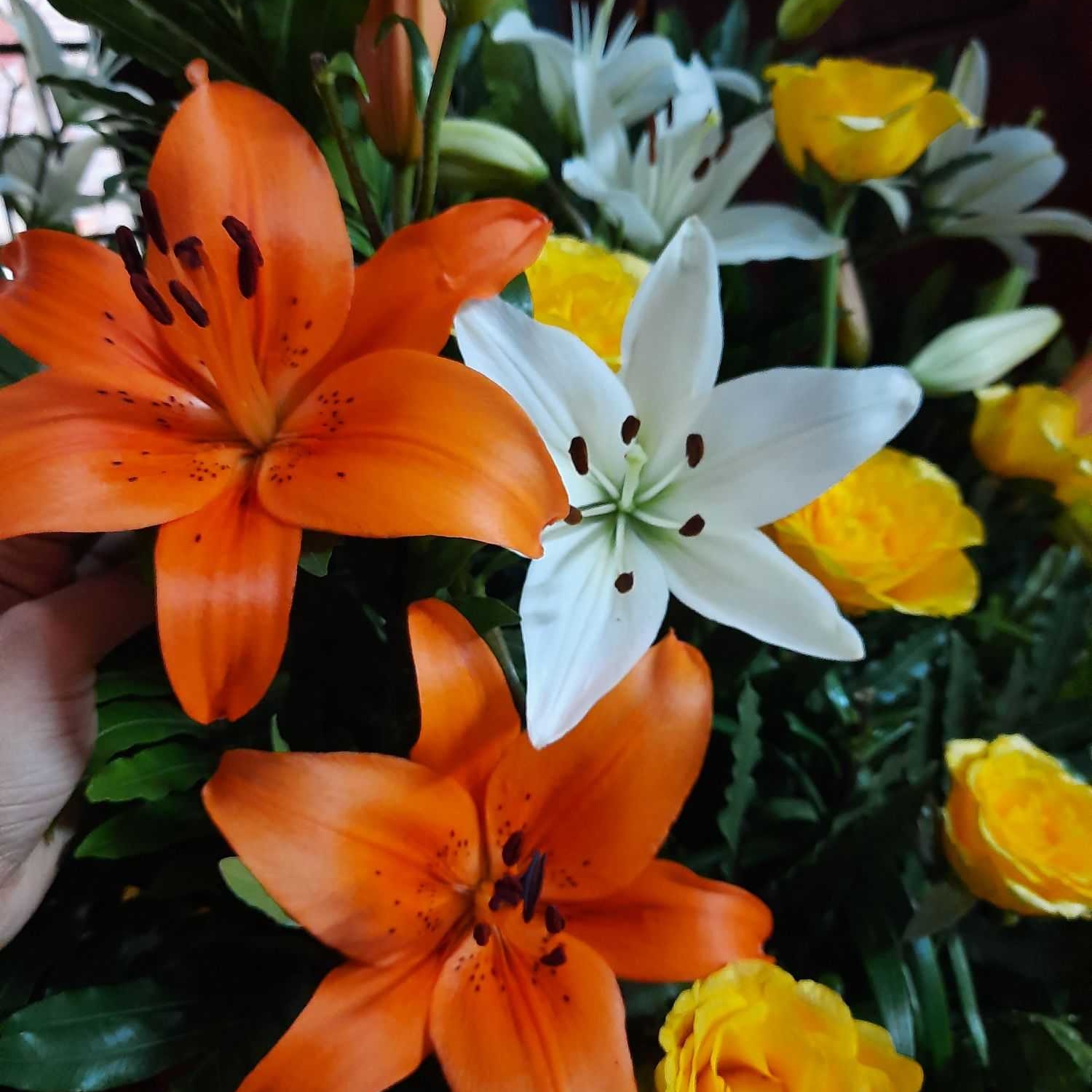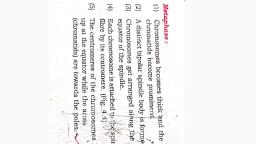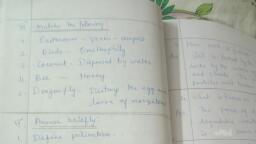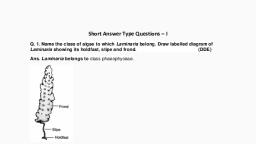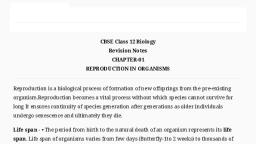Page 9 :
Ideal Biology Practical Hand Book – XII, , Q.1, A-1, , 1, , Dissect the given Flower and Display, its Different Floral Whorls, , Introduction:, (1), , A flower is highly condensed and modified shoot for sexual reproduction which results into, seeds and fruit after pollination and fertilization., , (2), , A typical flower has four types of floral leaves called sepals, petals, stamens and carpels in, distinct whorls known as calyx, corolla, androecium and gynoecium respectively., , (3), , The sepals and petals do not directly involved in sexual reproduction therefore, they are called, non-essential floral organs, while the stamens and carpels are directly involved in sexual, reproduction are called essential organs., , Q.1. Dissect the given flower and display its different whorls. Sketch and label the, diagram., (4 marks), Aim, : To dissect out the given flowers and display their various parts., Requirements, : Dissecting microscope, Needle, forceps, razor blade, two needles, slides,, watchglasses, flowers such as Hibiscus, Brassica or Catharanthus., Procedure :, (1) Obtain the fresh flowers of Hibiscus, Brassica or Catharanthus and observe their, colour, shape and size., (2) Identify various floral whorls like calyx, corolla, androecium and gynoecium., (3) Note whether the flower is, (a) Pedicellate or Sessile (b) Actinomorphic or Zygomorphic, (c) Unisexual or Bisexual, (4) Remove the sepals and place them on a wet filter paper in a watchglass., (5) Similar to sepals, remove petals and stamens and arrange them in separate watch, glasses., (6) Count the number of sepals, petals and stamens., (7) Note whether the sepals and petals are free or united. Note their aestivation., (8) Remove the gynoecium and place it in a watch glass., (9) Observe and note any other special features of the flowers., (10) Draw labelled diagrams of different whorls., (11) Note down your observations as Observations:, Following features can be seen in the given flowers., (A) Hibiscus rosa-sinensis (Jaswand):, Family, : Malvaceae, Flower, : Complete, pedicellate bracteate, hermaphrodite, actinomorphic, and hypogynous, Epicalyx, : There are 5 - 7 free green bracteoles., Calyx, : Sepals-5, green, gamosepalous, campanulate, valvate, aestivation, Corolla, : Petals-5, polypetalous, large, showy and red coloured, twisted, aestivation., (1)
Page 11 :
Ideal Biology Practical Hand Book – XII, , Androecium, Gynoecium, , 3, , : Stamens-6 in two whorls (2 + 4), polyandrous, tetradynamous,, 2 outer short and 4 inner long, dithecous., : Bicarpellary, syncarpous, style short, stigma bilobed., , Fig. 2. Floral parts of Brassica (Mustard), , VIVA VOCE, (1) Define flower:, Ans: A flower is a highly modified, condensed, reproductive shoot in Angiosperms., (2) What is the function of flower?, Ans: A flower is the reproductive organ in plants. It possesses male and female sex, organ for sexual reproduction., (3) Which are the essential floral whorls?And why?, Ans: Essential floral whorls include Androecium and Gynoecium. They produce, the male and female gametophytes for sexual reproduction., (4) What is the difference between polypetalous and gamopetalous corolla?, Ans: A corolla is said to be polypetalous when the petals are free. It is gamopetalous, when the petals are united/fused., (5) Which are the different parts of stamen and carpel?, Ans: A stamen consists of two parts - filament and anther., A carpel consists of three parts - ovary, style and stigma., (6) How does Brassica flower is different from that of Hibiscus?, Brassica, Hibiscus, Ans:, Tetramerous symmetry, Pentamerous symmetry, Stamens 6, Stamens numerous, Ovary-Bicarpellary, Ovary pentacarpellary, Parietal placentation, Axile placentation
Page 13 :
OR, , Ideal Biology Practical Hand Book – XII, , Q.1, , 5, , Isolation of DNA from Given Sample, , Introduction:, (1) Recombinant DNA technology has enormous potential in agriculture, medicine and enviornment., (2) It involves isolation of DNA from a variety of sources to produce recombinant DNA., (3) DNA can be isolated from a tissue by separating it from the cellular fluid and proteins., , Q.1. Perform the experiment to isolate DNA from given sample. Show your result to, the examiner., (4 marks), Aim, : To extract and isolate DNA from a fruit sample., Requirements, : Fleshy berry fruits e.g. Banana, grapes etc. Mortar and pastle, liquid, soap, distilled water, NaCl, 100 ml of ice cold IPA (Isopropyl alcohol),, measuring spoons, glass rod, test tubes, beakers, strainer, funnel etc., Principle, : All the plants-DNA extraction protocols, involve the basic steps of, distruption of cell wall, cell membrane and nuclear membrane to, release the DNA into solution followed by precipitation of DNA and, ensuring removal of the contaminating biomolecules., Diagram:, Cut, , Floating DNA, IPA addition, along the walls, , IPA, , (A), , Mash the, banana, well, , Filtrate, , Mixture, , (E), , (F), , Add Liquid, Soap + Salt, + Water, , Mixture, Filter Paper, , (B), , Filter the, solution, , Mi, xw, el l, , Tea Strainer, Filtrate, , (C), , (D), , Fig. 3. Isolation of DNA, , Procedure:, (1) Grind a small amount of fruit tissue in a mortar with little amount of distilled, water., (2) Filter the solution in a beaker and add 1 teaspoon of liquid soap, 1/4 teaspoon, of salt and 2 tablespoons of distilled water., (3) Stir the mixture with a glass rod until the soap and salt are dissolved., (4) After 10-15 minutes, filter the mixture through a strainer., (5)
Page 14 :
Ideal Biology Practical Hand Book – XII, , 6, (5), , Take a test tube with chilled isopropyl alcohol and add the above filterate slowly, with the help of a dropper., (6) Leave the test tube undisturbed for a few minutes., (7) The precipitated DNA is visible as fine white threads that can be removed by, spooling using a glass rod., Observations: DNA precipitates as fine, white threads., VIVA VOCE, (1) Where is DNA found in the cell?, Ans: In a typical eukaryotic cell, DNA is found in the nucleus, mitochondria and, chloroplasts., (3) Why salt is added to isolate DNA?, Ans: During isolation of DNA salt is added to neutralise the DNA charge and make, the molecule less hydrophilic i.e. less soluble in water. The salt also removes, proteins that are bound to DNA., (3) What is the role of detergent in isolation of DNA?, Ans: During the extraction of DNA, the detergent removes the lipids of cell, membrane and nuclear membrane so as to release the DNA from the cell., (4) Why is chilled condition required during the expreiment?, Ans: During DNA isolation, chilling is necessary to increase the rate of precipitation, of DNA. It also protects the DNA from the activity of cytoplasmic DNAse., MULTIPLE CHOICE QUESTIONS, (1) Which of the function is not performed by DNA?, (a) Synthesis of protein, (b) Transmission of hereditary character, (c) Synthesis of carbohydrates, (d) Replication, (2) Purines of DNA/RNA are ___________ ., (a) Uracil and guanine, (b) Uracil and cytosine, (c) Adenine and guanine, (d) Cytosine and Guanine, (3) Mark the correct statement:, (a) Histones are acidic proteins, (b) Histones stimulate genetic activity, (c) Histones are basic proteins, (d) Nucleosomes are formed in E. coli, during packaging, (4) Which of the following nucleotide sequences has 4 pyrimidine bases?, (a) GCUAGACAA, (b) UAGCGGUAA, (c) GATCAATGC, (d) GCAAGAUCAA, (5) A nucleoside is ________ ., (a) A pentose sugar ribose or deoxyribose + a nitrogen base, (b) A nucleotide + phosphate, (c) A pentose sugar + a phosphate, (d) A pentose sugar ribulose + a N2 base, Ans: (1) - (c), (2) - (c), (3) - (c), (4) - (c), (5) - (a)., Remark : _________________, , Teacher's Signature : _________________
Page 15 :
Ideal Biology Practical Hand Book – XII, , Study of Plant Population Density, by Quadrat Method, , Q.2, , 7, , Introduction :, (1), , Various types of plants growing at a particular space or geographical area at a particular time is, called the plant population of that area. It varies from time to time due to various factors., , (2), , The number of individuals of a species present per unit area at a given time is called population, density., , (3), , Population frequency of a species is defined as, total number of quadrats in which a species, occured per total number of quadrats studied., , Q.2. Calculate population density of any one plant species by quadrat method., (3 marks), Aim, : To determine the population density of plants by quadrat method., Principle, :, (1) All the plants of a species growing in a geographical area at a particular time,, forms plant population of that area., (2) It changes from time to time and may increase or decrease due to various, factors., (3) The number of individuals of a species present per unit area at a given time is, called population density., (4) It can be calculated as, , N, S, where, N = Number of individuals of species, and, S = Units of space or area (no. of quadrats), (5) The population density can be determined by marking quadrats of suitable, size and recording the number of individuals of each species occuring in the, quadrat., Requirements, : Metre scale, string or cord, nails, paper, pencil etc., Procedure:, (1) Select a field and a plant species to be studied in it., (2) Fix 4 nails A, B, C and D at a distance of 1 metre making a square area of 1m2., Tie a string around the nails to make a boundary., (3) The size of the quadrat should be determined on the basis of size and frequency, of the plant under study., (4) Count the number of plants under study lying inside the quadrat., (5) Lay the quadrat randomly at number of places and count the number of plant, species in each quadrat., (6) Record the data in the observation table., (7) Calculate population density using the fomula,, D, , =, , Population Density =, , Total number of individual s in all the quadrats studied, Total number of quadrats studied, , (7)
Page 16 :
Ideal Biology Practical Hand Book – XII, , 8, , B, Nail, B, , Nail, A, , Species 1, Species 2, Species 3, Species 4, 50 cm, String, , Plants, outside, the quadrat, , Nail, C, , Nail, D, , 50 cm, , Fig. 4. Diagrammatic representation of a quadrat., , Observation Table:, Sr. Plant, N o . species, , 1., , Spe. 1, , 2., , Spe. 2, , 3., , Spe. 3, , 4., , Spe. 4, , 5., , Spe. 5, , No. of, individuals, per quadrats, I, , II, , III, , IV, , V, , Total no. of, individuals, in all the, quadrats, studied (N), , 3, , 1, , 4, , 2, , -, , 10, , Total no. of, quadrats in, which the, species, occured (A), , Total no., of, quadrats, studied, (B), , 4, , 5, , Population, density, N, D =, B, , 10, = 2, 5, , Result:, Population density of the given plant species is ............... ., , Precautions:, (1), (2), (3), , The measurement of quadrats should be accurate., The string or cord used should not be very thick., One individual of a species should be counted only once in the quadrat.
Page 17 :
Ideal Biology Practical Hand Book – XII, , 9, VIVA VOCE, , (1) What do you mean by population?, Ans: Organisms of the same kind inhabiting the same geographical area constitute, a population., (2) What is population density? How it can be calculated?, Ans: Population density refers to the number of individuals present per unit space, at a given time. It is calculated using the formula Population Density =, , Total number of organisms in all the quadrats studied, Total number of quadrats studied, , (3) What is a quadrat?, Ans: A quadrat is a frame used in ecology and geography to isolate a standard unit, of area to study the distribution of an organism over a large area. It is a sampling, unit for study of vegetation., (4) How is frequency percentage calculated?, Ans: Frequency percentage is calculated by the formula as follows:, Frequency percentage =, , Total no. of quadrats in which the species occured, × 100, Total no. of quadrats studied, , (5) How to calculate obundance of plant species? Why should it be calulated in, quadrat studies?, Ans: Species abudance is the number of individuals per species. It is expressed as, percentage of the total number of species in a community. It is calutated by the, formula -, , Total number of individuals of the species, × 100, No. of quadrats in which they occur, Abudance value reaveals the status of a species in an ecosystem., (6) What is vegetation?, Ans: Vegetation is total numbers of plant species showing different life forms,, structure, spatial extent or showing any other special characteristics, specific to a, particular area., , Remark : _________________, , Teacher's Signature : _________________
Page 18 :
OR, , 10, , Ideal Biology Practical Hand Book – XII, , Study of Osmosis by Potato, Osmoscope, , Q.2, Introduction:, (1), , Osmosis is the diffusion or movement of solvent (water) from a region of higher water potential to, a region of lower water potential through a semipermeable membrane., , (2), , In osmosis, the fluid that permeates through the semipermeable membrane is called solvent,, whereas the solute is the dissolved particles in the fluid., , (3), , When two solutions of different concentrations are separated by a semipermeable membrane, the, solvent (water) flows from the hypotonic solution (with low solute concentration) to the region of, hypertonic solution (with high solute concentration)., , (4), , Osmosis in living cells may be endosomis or exosmosis., , (5), , Osmosis can be demonstrated by using peeled potato., , Q.1. Make a temporary potato osmoscope to study osmosis. Sketch and label the, diagram showing the change in the water level., (3 marks), Aim, : To study the process of osmosis using potato osmoscope., Requirements, : A fresh potato, peeler, scalpel, petridish/glass bowl, concentrated sugar, solution, coloured water., Diagram:, Potato, Final level, Initial level, Coloured water, Sugar solution, Beaker, (a) Potato osmoscope, initial set up, , (b) Potato osmoscope, final set up, Fig. 5. Potato Osmoscope, , Procedure:, (1) Take a fresh peeled potato tuber and cut it from one side to make a flat base., (2) Scoop the tuber with scalpel so as to make a cavity leaving a thin base., (3) Add concentrated sugar solution in the cavity and mark the initial level using, a pin., (4) Place the potato in a petridish or a glass bowl (Fig. 5) containg coloured water., (5) This set up is called potato osmoscope or potato osmometer., (6) Leave the set up undisturbed for a few hours., (7) Observe the level of sugar solution., (10)
Page 19 :
Ideal Biology Practical Hand Book – XII, , 11, , Observations:, After a few hours the level of sugar solution in the potato asmoscope rises and the, solution becomes coloured., , Conclusions:, (1), (2), (3), , The rise in the sugar solution is due to osmosis., The membranes of the living cells of potato tuber function as semipermeable, membrane., Water from outside (hypotonic) enters the cavity filled with concentrated sugar, solution (hypertonic) thus demonstrating osmosis., VIVA VOCE, , (1) Potato is used to prepare an osmoscope. Justify., Ans: Peeled potato represents a living system to demonstrate the process of osmosis., The cell membranes of potato act as the semipermeable membranes and allow, the passage of water from hypotonic solution to hyperonic solution., (2) Define permeability., Ans: Permeability is defined as the property of membranes to allow passive diffusion, of molecules., (3) Define osmotic pressure, Ans: Osmotic pressure is equivalent to the pressure which must be exerted upon, the solution to prevent the flow of solvent across a semi-permeable membrane., (4) Do you find any role of osmosis in water purification?, Ans: In water purification, reverse osmosis is used. It is the reverse movement of, water through a semipermeable membrane from a more concentrated solution to, a more dilute solution by applying external presure on the more concentrated, solution. It is used for removing salts from saline water., (5) Osmosis plays important role in stomatal movement. Explain., Ans: Stomatal movement depends on the turgidity of guard cells., Guard cells become turgid due to endosmosis and the stoma opens., Guard cells become flaccid due to exosmosis and the stoma closes., (6) What is the use of osmosis to plant cell., Ans: The cells maintain their turgidity by this process, roots absorb water from, the soil by this process., (7) Why did you use sugar solution?, Ans: Any strong solution such as of salt also can be used. It is used to develop, osmotic difference/suction pressure., (8) Why the set up of potato is called osmometer/osmoscope?, Ans: It is so called because the difference in the initial and find levels of solution, in the potato is cavity can be measured/seen which is due to osmosis.
Page 20 :
Ideal Biology Practical Hand Book – XII, , 12, , MULTIPLE CHOICE QUESTIONS, (1) In living cells, an osmosis specifically refers to the __________., (a) diffusion of solvent, (b) diffusion of solute, (c) diffusion of water, (d) diffusion of solute and solvent both, (2) The direction and rate of osmosis is controlled by ____________., (a) nature of property of membrane, (b) nature of solvent, (c) pressure gradient and concentration gradient, (d) cell structure and composition of cytoplasm, (3) The structure that contributes to the solute potential of a cell is ____________ ., (a) vacuolar sap, (b) cell sap, (c) water, (d) solute particles, (4) Osmotic potential refers to _________ ., (a) movement of water molecules from hypotonic solution to hypertonic solution, (b) movement of water molecules from hypertonic solution to hypotonic solution, (c) pressure potential, (d) movement of water molecules from hypotonic to isotonic solution, (5) Which of the following is not semipermeable?, (a) Parchment paper, (b) Egg membrane, (c) Bladder membrane, (d) Cell wall, (6) Which acid is used to extract egg membrane?, (a) Acetic acid, (b) Dilute HCl, (c) Concentrated HCl, (d) Dilute H2SO4, (7) With reference to tonocity the solution outside the osmoscope should be _______ ., (a) Hypertonic, (b) Hypotonic, (c) Isotonic, (d) Dilute, Ans: (1) - (c), (2) - (c), (3) - (d), (4) - (a), (5) - (d), (6) - (a), (7) - (b)., , Remark : _________________, , Teacher's Signature : _________________
Page 21 :
Ideal Biology Practical Hand Book – XII, , Study of Soil, Samples for its Type, , Q.3, , 13, , Introduction :, (1), (2), (3), , (4), , The soil is the uppermost layer of earth which has humus and numerous living organisms along, with their dead remains. It sustains the plant life., A productive soil has approximately 40% minerals, 10% organic matter, 25% water and 25% air., The soil may have different sized particles which can be classified as, (i), Clay (less than 0.002 mm), (ii) Silt (0.002 to 0.05 mm)), (iii) Fine sand (0.05 to 0.5 mm), (iv) Coarse sand (0.5 to 2 mm), (v) Gavel (more than 2 mm), The soil may be sandy, sandy loam, loam, silty loam, clayey loam or clay., , Q.3. Perform the suitable tests to compare the given soil for its type. Make a note on, its soil type., (3 marks), Aim, : To study the texture/type of soil collected from different sites., Principle, : Soil texture is the property of soil depending upon the nature and, composition of its particulate matter. Study of soil texture (type) is, one of the important parameters used for various purposes e.g., Agriculture, construction, mining, etc., Requirments, : Soil samples from garden, roadside and beach, lens, meshes of different, pore size, measuring cylinder and stirrer., Procedure:, (1) Collect the soil samples from different sites, and bring them to the laboratory., (2) With the help of hand lens examine the soil, samples, also place the soil samples on the, Humus, meshes of different sizes and record the, different sizes of the particles found., Water, (3) Examine the soil samples and feel them with, the fingers in dry as well as wet conditions., Clay, (4) Take 3 measuring cylinders and label them, Silt, as A, B and C for garden, roadside and the, Fine sand, beach soil respectively., Coarse sand, (5) Take about 50 gm of each soil sample in, Fig. 6. Composition of soil, 250 ml measuring cylinder., (6) Add 200 ml of water and stir it well., (7) Allow the soil particles to settle down for 15 minutes., (8) Various soil particles will settle in the cylinder to form various layers., (9) Record the thickness of each layer and calculate the percentage of each layer, to identify the soil type using the formula Width of layer x, , Percentage of layer x = Total width of all the layers (excluding humus) × 100, where, x is a layer of soil like clay, silt or sand., (13)
Page 22 :
Ideal Biology Practical Hand Book – XII, , 14, , Observations:, Observe and measure the comparative layers formed in each jar and, classify the soil as per guidlines given below:, No. Types of soil, , Location, , Composition, , 1., , Sandy soil, , Near the mountain foot-hills, along rivers,, streams and certain coastal areas., , 80 - 100% sand,, 0 - 10% silt, 0 - 10% clay, , 2., , Loam soil, , Valleys and flat areas (food plains),, surrounding rivers and streams, , 25 - 50% sand, 30 - 50% silt, 10 - 30% clay, , 3., , Clay soil, , Very common in certain areas,, particularly around urban, , 0 - 45% sand, 0 - 45% silt, 50 - 100% clay, , (1), (2), , Sandy soils have poor water holding capacity due to very low organic content., Loam soils are somewhat heavier than sandy soils, but also have poor water, holding capacity due to very low organic content., Clay soils are heavy and difficult to work when dry., , (3), , 0 - 10% Clay, 0 - 10% Silt, , 10 - 30% Clay, 50 - 100% Clay, , 30 - 50% Silt, 80 - 100% Sand, , (a) Sandy soil, , 0 - 45% Silt, 0 - 45% Sand, , 25 - 50% Sand, , (b) Loam soil, (c) Clay soil, Fig. 7. Composition of different types of soils, , Conclusion:, Texture of soil depends on its composition and varies from place to place. Hence, garden soil and beach soil have different texture i.e. fine or coarse., , Result:, Sr., No, , Soil, Sample, , 1., , Garden soil, , 2., , Road side soil, , 3., , Beach soil, , 4., , Crop field, , 5., , A dried pond, , Colour, of soil, , Relative percentage of, Sand, Silt, Clay, , Soil, texture/type
Page 23 :
Ideal Biology Practical Hand Book – XII, , 15, , Types of soil and its correlation with the plants found(1) Mesophytes are found in well watered garden soil., (2) Xerophytes are found in dry desert soil., (3) Halophytes are seen in saline soil., VIVA VOCE, (1) What is soil?, Ans: The soil is the uppermost layer of the earth with humus and numerous living, organisms alogwith their dead remains that sustains the plant life., (2) How soils are classified?, Ans: The various types of soil are Sandy, Sandy loam, loam, silty loam, clayey loam and clayey., (3) Enlist the components of soil., Ans: A typical productive soil contains minerals, organic matter (dead remains of, plants and animals), water and air., (4) Why soil pH and soil texture are given importance in the study of soil?, Ans: Soil pH is a measure of acidity or alkalinity of the soil. Soil texture is an, important parameter for agriculture construction, mining etc., (5) Explain the corelation between the living plants (living organisms) and soil pH., Ans: Soil pH is important to the living plants because it determines the availability of, essential nutrients. At a soil pH 6.5, maximum nutrients are available to the plants., MULTIPLE CHOICE QUESTIONS, (1) Plants grow in saline soil are known as __________., (a) Xerophyte, (b) Halophytes, (c) Epiphytes, (d) Mesophytes, (2) Which of the following soil type has more water holding capacity?, (a) Sandy soil, (b) Loam soil, (c) Clay soil, (d) Both sandy and loam soils, (3) What is the percentage of sand in clay soil?, (a) equal to silt, (b) equal to clay, (c) more than silt, (d) both (a) and (c), (4) Which of the following branch is deals with the study of soil?, (a) Palantology, (b) Pedology, (c) Phytology, (d) Cytology, (5) _____________ is considered as pioneer community in xerarch?, (a) Planktons, (b) Algae, (c) Crustose lichen, (d) Foliose lichens, Ans: (1) - (b), (2) - (c), (3) - (a), (4) - (b), (5) - (c)., Remark : _________________, , Teacher's Signature : _________________
Page 24 :
OR, , 16, , Q.3, , Ideal Biology Practical Hand Book – XII, , Study of Water Samples for its pH, , Introduction :, (1), (2), (3), , pH is a measure of the acidity or alkalinity of water., The pH of water is primarily decided by the salts present in soil from where the water sample, is collected., But pH also changes due to organic matter, fertilizers, sewage and other pollutants., , Q.4. Perform the suitable test to compare the given water samples for their pH., (3 marks), Aim, Requirements, , : To study pH of various water samples., : Universal indicator or pH paper, water samples from pond, river, lake,, well, sea, etc. in separate beakers, test tubes., , Procedure:, (1) Take 10 ml of water sample in a test-tube and put 5 drops of universal indicator, in it or dip pH paper in it., (2) Observe the colour change and match it with the pH colour chart., (3) Record the observations., (4) Repeat the experiment with all other water samples given., (5) Alternatively pH paper strips can be used and the colour change can be matched, against the colour chart as follows:, (i) Dip a small piece of broad range pH paper in each of the water sample solution., (ii) Match the colour of pH paper with the colour scale given on the pH paper, booklet. This gives approximate pH., (iii) For more accurate value, take a piece of narrow range pH paper of the value, indicated by broad range pH paper and dip them separately in the soil solution., (iv) Match the colour of the papers with the pH scale given on the pH paper, booklet. This will give the correct value of the pH of the water samples., , pH, 1, 2, 3, 4, 5, 6, 7, 8, 9, 10, 11, 12, 13, 14, , Dropper, , pH, 6.2, 6.4, , 6.6, 6.8, 7.0, 7.2, 7.4, 7.6, , Water sample, with universal, indicator, , 7.8, 8.0, , Wide range pH paper, , Narrow range pH paper, , (A), , (B), Fig. 8. Study of pH of Soil, , (A) pH Papers (B) Water sample with universal indicator, , (16)
Page 25 :
Ideal Biology Practical Hand Book – XII, , 17, , Observations:, Water samples collected from different sources have different pH values., Sr. No., , Water sample, , 1., , Pond water, , 2., , Lake water, , 3., , Sea water, , 4., , Well water, , 5., , River water, , pH, , Nature of water (Acidic/Alkaline/Neutral), , Conclusion:, pH of water is an indicator of impurities. Pure water has neutral pH i.e. 7, pH less, than 7 indicates acidic nature, pH more than 7 indicates alkaline nature., Precautions:, (1) Take clean and dried test tubes., (2) Dry the pH papers before comparing the colour with the colour scale., (3) Match the colour carefully and determine pH accurately., VIVA VOCE, (1) Why is turbid water not suitable for consumption?, Ans: Turbid water may cause gastrointestinal disorders, nausea and headache., The particles of turbidity shield the microorganisms against disinfectants. Thus, turbid water is difficult to clean using disinfectant., (2) What is Biochemical Oxygen Demand (BOD)?, Ans: BOD is Biochemical Oxygen Demand. It is the amount of dissolved oxygen, demanded by aerobic biological oxidation by microorganisms., (3) What is water pollution?, Ans: Water pollution refers to addition of harmful substances, chemical or, microorganisms that degrade the quality of water and make it unsuitable/toxic to, living organisms., (4) What are the causes of water pollution?, Ans: Domestic sewage, industrial effluents, excess fertilizers and pesticides are, the common causes of water pollution., (5) What are planktons? Is there any difference in the planktons occuring in fresh, water and sea water?, Ans: Planktons are microscopic organisms found in seawater or fresh water., (6) ‘pH measurement with indicator paper is not very accurate’. Comment., Ans: It is correct that the measurement with the pH indicator paper is not as, much accurate as the pH meter because indication made by the pH paper is, subjective and different people see the colour change at the different point. Also,, the use of pH indicator paper is known to be the destructive process and the solution, used for indication cannot be used afterwards.
Page 26 :
Ideal Biology Practical Hand Book – XII, , 18, , MULTIPLE CHOICE QUESTIONS, (1) ____________ arthropods found in fresh water bodies., (a) Daphnia, (b) Hermit crab, (c) Amphipod, (d) Padina, (2) BOD of water means ____________., (a) Biological oxygen demand, (b) Biochemical oxygen demand, (c) Biologically observed diatoms, (d) Biologically observed Daphnia, (3) Methylene blue stain is used to observe ____________ ., (a) Plankton, (b) Bacteria, (c) Algae, (d) Viruses, (4) Experimental set up deviced by _______ is used to observe water clarity., (a) Wingbarg, (b) Tyndall, (c) Strassburger, (d) Waldeyer, (5) If pH is less than ____________ then water is acidic., (a) 6.5, (b) 10.5, (c) 4.5, (d) 12.5, (6) If the pH is more than ____________ then water is alkaline., (a) 6.5, (b) 7.5, (c) 10.5, (d) 12.5, Ans: (1) - (a), (2) - (b), (3) - (b), (4) - (b), (5) - (a), (6) - (b)., , Remark : _________________, , Teacher's Signature : _________________
Page 27 :
Ideal Biology Practical Hand Book – XII, , Identify the Spots ‘A’ to ‘J’ as per the, Instructions, , Q.4, , Q.4. Identify and describe the spots as per instructions., , Spot-A :, , 19, , (10 marks), , Study of flowers adapted to pollination by different, pollinating agencies (Wind and Insects), , Introduction:, (1), Higher plants reproduce by seed formation for which union of male and female gametes is, compulsory., (2), , Male gametes are produced in pollen grain while female gametes are produced in the ovule., , (3), , The process of transfer of pollen grains from anther to the stigma of either the same flower, or another flower of the same species is called pollination., , (4), , Pollen grains are non-motile, hence require external agencies to reach to the stigma., , (5), , The external agencies involved in pollination may be, (i), , Abiotic. (e.g. Wind, water) or, , (ii), , Biotic (e.g. Insects, birds, bats, snails), , Aim, Requirements, , : To study different adaptations shown by flowers for pollination., : Fresh flowers of Maize or any other cereal/Grass, Salvia or Ocimum/, Sunflower/Brassica, forceps, hand lens, slide, needle, etc., , Procedure:, (1) Observe the given flower on a slide and observe it with the help of hand lens., (2) Note down the adaptations of flowers for pollination by respective agencies., Maize (Wind pollination), (1), (2), , In maize, pollination is brought about by wind (Anemophily)., The flowers are unisexual and plant is monoecious. Male inflorescence is, terminal while the female inflorescence is axillary., (3) It shows following adaptations:, (i) The flowers are small, inconspicuous and not showy., (ii) The flowers are colourless, odourless and nectarless., (iii) Flowers are produced above the foliage or placed in hanging position., (iv) They produce large number of pollen grains., (v) Both the stigmas and anthers are exerted (i.e. hang outside the perianth)., (vi) Perianth is reduced to two lodicules., (vii) Anthers are versatile, pollens are light in weight and large in number., (viii) Stigma is hairy, feathery and branched to catch the wind born pollen, grains., , (19)
Page 28 :
Ideal Biology Practical Hand Book – XII, , 20, , Versatile, stamens, , Male flowers, , Pollen grains, , Staminate flower, , Long, style, , Tassel, , Pistillate flower, , Feathery, stigma, , Cob, , Versatile, anther, , Elongated styles, , Ovary, Maize, , Grass, Fig. 9. Pollination in Maize, , Salvia (Insect pollination), (1), , Salvia is a typical entomophilous flower and pollination is brought about by, honeybees., , (2), , Flower are attractive and have bright colour., , (3), , Flowers have nectar and nectar glands are situated in such a way that the, insect’s body parts touch the anthers and stigma as it tried to reach the glands., , (4), , Salvia flowers have bilobed corolla with two stamens attached to corolla., , (5), , Each of the two anthers has only one fertile lobe. The sterile halves of both the, anthers join to form a plate placed above the lower lip at the mouth of the, flower., , (6), , The connective is elongated so that the fertile anther lobes become far apart, and situated under the hood of the upper lip of corolla [Fig. 10 (a)]., , (7), , When a bee lands on the lower lip and tries to suck nectar, the sterile plate is, pushed down; the fertile anther is brought down and dusts the pollens on the, back of bee [Fig. 10 (b)]., , (8), , In flowers which have dispersed their pollen, the stigma hangs down [Fig. 10 (c)]., , (9), , When this type of flower is visited by a bee loaded with pollen on its back, the, stigma touches its back and pollination is affected [Fig. 10 (d)].
Page 29 :
Ideal Biology Practical Hand Book – XII, , 21, , Closed stigma, Fertile anther lobe, Shedding of, pollen grains, on the back, of insect, Nectariferous disc, , (a), , (b), Stigma receiving, pollen grains from, the back of insect, , Mature stigma, , (c), , Withering, , (d), , Fig. 10. Various stages in the pollination of Salvia flower by a honeybee, , VIVA VOCE, (1) What is pollination?, Ans: Transfer of pollengrains from anther to stigma of a flower is called pollination., (2) Differentiate between self and cross pollination., Ans: Self pollination is a type of pollination in which bisexual flower is pollinated, by its own pollengrains., Cross pollination is a type of pollination in which pollengrains of one flower are, deposited on the stigma of a flower of a different plant of the same species., (3) Give reason as to why do maize as well as Saliva plants show cross pollination?, Ans: Maize bears unisexual flowers in separate inflorescences on the same plant, and hence cross pollinated. Salvia is dichogamous and protandrous with anthers, maturing before stigma. Thus cross pollination is compulsory., (4) Explain the term: (a) Autogamy (b) Allogamy (c) Geitonogamy, Ans: Autogamy is self pollination in which a bisexual flower is pollinated by its, own pollengrains., Allogamy is cross pollination in which the stigma is pollinated by pollengrains of, another plant., Geitonogamy is the transfer of pollengrains to the stigma of another flower produced, on the same plant., (5) ‘Pollination is pre-requisite for fertilization in flowering plants’- Explain/comment., Ans: In Angiosperms both, the male and female gametes are non-motile and are, produced at two different sites. Hence fertilization is possible only after pollination., , Remark : _________________, , Teacher's Signature : _________________
Page 30 :
Ideal Biology Practical Hand Book – XII, , 22, , Spot-B:, , Study of Meiosis in Onion flower Bud with the, help of Permanent Slides, , Introduction:, (1), (2), (3), (4), (5), (6), , Meiosis is a reductional cell division that divides a diploid cell into 4 haploid daughter cells., It occurs in germinal/reproductive cells to produce gametes., It involves two divisions: Meiosis I and Meiosis II., Meiosis I results in reduction of chromosome number., Meiosis II maintains the chromosome number but is necessary to reduce the amount of, DNA that was doubled due to DNA replication., The summary of various stages of Meiosis are as follows:-, , Meiosis, Meiosis-I, , Meiosis-II, , Prophase-I, , Metaphase-I, , Anaphase-I, , Telophase-I, , Leptotene, , Zygotene, , Pachytene, , Diplotene, , Prophase - II, , Aim, Requirements, Procedure, Observations, , Metaphase - II, , Cytokinesis, , Diakinesis., , Anaphase - II, , Telophase - II, , : To study meiosis in Onion buds/Tradescantia buds., : Permanent slide of different stages of meiosis, microscope., : Focus the permanent slides of onion bud cells under the low and high, power of compound microscope and observe the various stages of meiosis., : Following stages are distinctly observed under the high power of, compound microscope., , (A) Meiosis I, (I), , (II), (III), , (IV), , (a) Karyokinesis-I: It takes place in four step stages , Prophase I:, (i) Leptotene : Beaded chromosomes are seen. Nuclear membrane and nucleolus, are distinct., (ii) Zygotene : Homologous chromosomes are seen as bivalents. Pairing is called, synapsis., (iii) Pachytene: Two chromatids of each chromosome become visible so that, bivalents appear as tetrads., Crossing over is visible at one or more points called chiasmata., (iv) Diplotene : Homologous chromosomes depart and are held only at chiasmata., (v) Diakinesis : Nucleolus and nuclear membrane disappear and spindles being, to appear., Metaphase I: The bivalents get arranged along the equatorial plane of the spindle., Anaphase I: Homologous chromosomes separate and move to opposite poles. Each, pole has half the original number of chromosomes each with two, chromatids., Telophase I: Chromosomes relax. Nuclear membrane and nucleolus reappear., (22)
Page 31 :
Ideal Biology Practical Hand Book – XII, , 23, , (b) Cytokinesis-I:, (1) It occurs by formation of cell plate (in plant), which is formed at the equator of, the dividing cell., (2) Two daughter cells formed each with single haploid nucleus., Cell membrane, Nuclear membrane, Chromosomes, Nucleolus, , Zygotene, (Pairing of homologous chromosomes), , Leptotene, (Thread like chromosomes), , Cell membrane, Nuclear membrane, Paired chromosomes, (Tetrad), Nucleolus, Chromosomes showing, crossing over, Pachytene, (Crossing over occurs), , Diplotene, (Chiasmata formation), , Spindle fibres, Pole, Paired chromosomes, , Diakinesis, (Ring shaped Chromosomes), , Metaphase I, (Chromosomes on Equator), , Chromosomes (moving to poles), Cell plate, Nucleolus, (reappears), Chromosomes, Nuclear, membrane, (reappears), Anaphase I, Telophase I and Cytokinesis, (Homologous Chromosome move, to opposite pole), Fig. 11. Stages of Meiosis - I in Onion bud cell
Page 32 :
Ideal Biology Practical Hand Book – XII, , 24, , (B), (a), , Meiosis-II, , Karyokinesis-II: It consists of four sub-stages, (I), , Prophase II, , (II), , Metaphase II, , (III), , Anaphase II, , (IV), , Telophase II, , : Chromosomes are condensed. Nucleolus and nuclear, membrane disappear., : Chromosomes are seen arranged along the equatorial, plane of the cell. Two spindles are formed at right angles, to the spindle of Meiosis I., : The sister chromatids of each chromosomes separate and, migrate to opposite poles., : Chromosomes relax. Nuclear membrane and nucleolus are, reconstituted around each group of chromatids. 4 nuclei are, seen., , Nuclear, membrane, , Chromosomes, , Nucleolus, , Spindle fibres, , Prophase II, , Metaphase II, Nuclear, membrane, (forming), , Chromosomes, moving, to poles, , Nucleolus, (forming), Chromosomes, rearranging into, chromatin, Anaphase II, , Telophase II and Cytokinesis-II, , Fig. 12. Stages of Meiosis-II in Onion bud cell, , (b), , Cytokinesis-II:, (1) In plant, cell plate formation takes place at the centre of cell., (2) It forms four daughter cells called as tetrads. Thus, in the process of meiosis,, single diploid cell gives rise to four daughter cells which later metamorphose, to form either spores or gametes.
Page 33 :
Ideal Biology Practical Hand Book – XII, , 25, , VIVA VOCE, (1) Differentiate :, (a) Mitosis and Meiosis, Ans: Mitosis is equational division that occurs in somatic cells. Meiosis is, reductional division that occurs in germinal cells. Mitosis results in two daughter, cells while meiosis produces 4 daughter cells., (b) Anaphase I and Anaphase II, Ans: Anaphase I involves separation of homologous chromosomes while in, Anaphase-II, sister chromatids are separated. Anaphase I is not similar to Anaphase, of mitosis. Anaphase II is similar to Anaphase of mitosis., (c) Metaphase I and mitotic metaphase, Ans: In metaphase I, chromosome pairs are arranged along the equatorial plate., In metaphase of mitosis, chromosome are arranged along the equatorial plate. In, metaphase I, spindle fibres attach the centromere of chromosome to one pole. In, metaphase of mitosis, the spindle fibre attaches the chromosome to both the poles., (d) Zygotene and pachytene, Ans: Zygotene is the second stage of prophase I of meiosis. It involves pairing of, homologous chromosomes. Pachytene is the third stage of prophase I of meiosis. It, involves crossing over between non-sister chromatids of homologous chromosomes., (2) Write significance of Meiosis., Ans: They are (i) Meiosis produces gametes that participate in sexual reproduction., (ii) It maintains the fixed number of chromosomes in sexually reproducing, organisms., (iii) It produces genetic recombinations., (3) Why should meiosis II occur, when a reduction in the chromosome number has, already occurred in meiosis I?, Ans: Prior to meiosis, there is DNA replication during the S-phase. Hence the, chromosomes are duplicated. During meiosis I, the homologous chromosomes, segregate thus reducing the chromosome number to half. To separate the sister, chromatids of chromosomes, meiosis II takes place., (4) What is corssing over?, Ans: Crossing over is exchange of genetic material between non-sister chromatids, of homologous chromosomes during meiosis., It results in new genetic combinations in the daughter cells., (5) Enlist the different stages of prophase I., Ans: The five phases of prophase I are Leptotene, Zygotene, Pachytene, Diplotene and Diakinesis., , Remark : _________________, , Teacher's Signature : _________________
Page 34 :
Ideal Biology Practical Hand Book – XII, , 26, , Spot-C:, , Study of Bagging/Tagging/Emasculation, (Specimens/Photographs/Diagrams), , Introduction:, (1), , Aim, , Plant breeding is a science of crossing different varieties of plants in order to improve their, characteristics., , (2), , The process of crossing two genetically different species of plants is called hybridization., , (3), , Various steps involved in hybridization are(i), , Selection of parents, , (ii), , Selfing of parents, , (iii), , Emasculation - Removal of stamens from the flowers which are to be pollinated., , (iv), , Pollination, Bagging and Tagging - After pollination the flower is bagged to avoid, pollination by any other pollen grain., , (v), , Crossing, , (vi), , Collecting hybrid seeds and growing F1 generation, , (vii), , Trials, multiplication and distribution., , : To comment on the exercises of hybridization through models/charts., , Requirement, : Chart or picture showing the technique of hybridization., Procedure:, (1) Collection of pollen grains:, Pollen grains from a flower of a selected male parent are collected. If crossing, is not done immediately, they are stored in clean and dry vials at cool place., Collection is done in the early hours of morning. Day, date and time of Anthesis, is recorded., (2) Emasculation:, It is a process of removal of stamens before maturity to avoid self pollination., In large sized flowers it is done with forceps or scissors. In crop plants such as, paddy, sorghum etc. which have smaller flowers, emasculation is carried out, using hot or cold water or in alcohol for 1-10 minutes., (3) Crossing:, Pollen grains are dusted on mature stigma of emasculated flower by temporarily, opening the bag. It can also be done by brushing the pollens or pollen grains, from male parents directly on stigma of emasculated flower. Date of crossing is, recorded on a tag., (4) Bagging, Tagging and Labelling:, After crossing the flowers are covered with small bags to prevent pollination by, undesired pollen grains. The bags may be of polythene, paper or muslin cloth, and are perforated so as to provide aeration to the flowers. A label is tagged on, the plant which displays the date of emasculation, crossing and information, about parents., , (26)
Page 35 :
Ideal Biology Practical Hand Book – XII, , 27, Forceps, , Anther, , Flower bud, , Bud open, Fig. 13. Emasculation (forcep method), Polythene, bag, , Tag, , Fig. 14. Bagging and tagging, , VIVA VOCE, (1) What is emasculation?, Ans: It is the removal of young anthers of the stamens in the plant selected as, femal parent, having bisexual flowers well before anthesis., (2) What is hybridization?, Ans: Hybridization is one of the methods of crop improvement undertaken to, combine the desired, useful characteristics from two different pure varieties of, plants species, selected as male and female parents., (3) What is the purpose of bagging the emasculated flower prior to artificial, pollination and after artificial pollination., Ans: Emasculated flowers are bagged prior and after artificial pollination to prevent, pollination by foreign pollens., (4) Why is it that emasculation and crossing are preferably done early in the, morning or late afternoon?, Ans: Practices of artificial pollination are generally performed early in the morning, or late afternoon as at these times, flowers are generally open., , Remark : _________________, , Teacher's Signature : _________________
Page 36 :
Ideal Biology Practical Hand Book – XII, Study of Plants found in Xerophytic, and Aquatic, Conditions/Habitats, and Comment on their, Spot-D:, B-6, Adaptations, , 28, , (1) XEROPHYTIC PLANTS, Introduction:, (1), , Useful inheritable variations in the structure of organism to adjust with the environmental, conditions are called adaptations., , (2), , The plants that grow in desert conditions are called xerophytes. All xerophytes are adapted, to reduce loss of water by transpiration., , (3), , Some xerophytes show presence of muscilage that helps in retaining water. Some plants, have latex that help retaining water and sealing the place of injury., e.g. Euphorbia, Calotropis, Acacia, Opuntia, Agave, etc., , Aim, Requirements, , : To study plants found in xerophytic conditions with respect to their, morphological adaptations., : Plants of Opuntia, Agave, Calotropis, Acacia, etc., , Description of Morphological Adaptations, (A) Opuntia dillenii (Nagphani):, (1) It is a succulent, drought resistant xerophyte growing wild in arid areas., (2) The leaves are modified to spines in order to reduce transpiration., (3) The stem becomes green, flattened to take over the function of photosynthesis, because the leaves are modified into spines. Stem is called phylloclade., (4) Phylloclades are with several nodes (areoles) and internodes. The areoles have, one or more spines which represent the leaves of axillary branch., (5) Bristles (Trichomes) are present to provide protection against grazing animals., (6) The stem is fleshy due to presence of mucilage that retains water. The stored, water is used during the unfavourable conditions., Spines, (modified leaves), Bristles, Stem (phylloclade), Bud, Node, , Internode, , Fig. 15. Opuntia dillenii, , (28)
Page 37 :
Ideal Biology Practical Hand Book – XII, , 29, Floral, buds, , (B), , Leaf, , Calotropis procera (Ruee):, (1) It is a non-succulent xerophyte., (2) It is a drought enduring desert, shrub., (3) The leaves are thick and, somewhat leathery., (4) The leaves and young, branches are covered by a, mealy coating along with hair, which acts as insulating, covering., (5) The plant contains latex., , Stem, , Fig. 16. Calotropis procera, , (C), , Bipinnately, compound, leaves, , Stipular, spines, Stem, Fig. 17. Acacia arabica, , Acacia arabica (Babhool):, (1) It is a non-succulent xerophyte., (2) The leaves are bipinnately compound., (3) The leaflets are very small to reduce, transpiration., (4) The stipules are modified to spines, to reduce transpiration and also to, protect plant against grazing animals., (5) The older parts of stem are covered, over by thick brown bark.
Page 38 :
Ideal Biology Practical Hand Book – XII, , 30, , (2) AQUATIC PLANTS, Introduction:, (1), The plants that live in abundance of water are called hydrophytes or aquatic plants., (2), , They are generally adapted to remain buoyant and avoid decaying and tearing effects of, water., , (3), , They have aerenchyma tissue., e.g. Hydrilla, Vallisneria, Eichhornia, Pistia, Nelumbo (Lotus), Typha, etc., , Aim, Requirements, , : To study plants found in aquatic conditions with respect to their, morphological adaptations., : Plants of Hydrilla, Eicchornia, Typha, etc., , Description of Morphological Adaptations, (A) Hydrilla:, (1) Hydrilla is submerged rooted hydrophyte i.e. grows entirely under water, found, in fresh water ponds., (2) It is attached to the substratum by means of poorly developed adventitious, roots., (3) The stem is soft and slender with thin membranous leaves in whorls of 3-8., The leaves are without cuticle and stomata., (4) Mechanical tissues like collenchyma and sclerenchyma are absent., (5) Conducting tissues are poorly developed., (6) Stem possesses aerenchyma and lancunae which provide buoyancy to the plant, and help in exchange of gases (O2 and CO2)., (8) The whole plant is covered over by mucilage to protect against rottening effect, of water., Flower, , Whorled leaves, Water, Node, Internode, , Stem, Root, Soil, Fig. 18. Hydrilla (a submerged hydrophyte)
Page 39 :
Ideal Biology Practical Hand Book – XII, , (B), , 31, , Eichhornia (Water Hyacinth or Jalkumbhi):, (1) Eichhornia is a free floating hydrophyte that grows in fresh water bodies., (2) The stem is offset that grows horizontal below the water surface. It is spongy, due to air spaces., (3) The leaves are produced at the node in clusters. The petioles are swollen due, to air chambers., (4) The lamina has water proof coating of cuticle., (5) Adventitious roots are also produced in clusters at nodes. They acts as balancers., (6) They have root pockets. Root hairs are absent., Leaf lamina, , Petiole (inflated), Offset (stem), Fibrous roots, Root pockets, Water, Fig. 19. Eichhornia - (a Free-floating hydrophyte), , (C), , Typha (Cat tail):, (1), , (2), , (3), , (4), , (5), , Typha is an amphibious anchored, hydrophyte that grows in shallow, waters and marshy places., The plant has a rhizomatous stem,, adventitious roots and emerged, leaves., The leaves are large linear, soft thick, and sub-cylindrical. They have, spongy texture., The large leaves are able to stand, erect because of the presence of, mechanical tissue., The leaves possess cuticle and, stomata on the emergent position., (Actually Typha is a hygrophyte), , Male spike, , Female spike, Floral shoot, , Emerged erect, spongy leaves, , Rhizome, Adventitious, roots, Fig. 20. Typha
Page 40 :
Ideal Biology Practical Hand Book – XII, , 32, , VIVA VOCE, (1) Enlist the morphological adaptations in xerophytic plants., Ans:, (i) Leaves are reduced to minimum size., (ii) Fleshy stems may store water., (iii) Deep spreading root sytem with root caps., (iv) Leaves with thick cuticle., (2) Write anatomical adaptations in desert plants., Ans:, (i) Stems with water storage tissue., (ii) Leaves with multilayered epidermis, sunken stomata, sclerenchymatous, hypodermis and bulliform cells., (iii) Mesophyll is well differentiated., (iv) Vascular tissue and mechanical tissue are well developed., (3) Enlist the morphalogical adaptations in aquatic plants., Ans:, (i) Root system is poorly developed., (ii) Root pockets protect the root tips., (iii) Leaves are large, flat with upper surface coated with cuticle., (iv) Petiole may be swollen to provide buoyancy to the plant., (4) Write anatomical adaptations in aquatic plants., Ans:, (i) Cuticle thin or absent., (ii) Well developed cortex with numerous air chambers to provide buoyancy and, to facilitate gaseous exchange., (iii) Mechanical and vascular tissues are poorly developed., (iv) Stomata may be absent or may be confined to upper surface only., (5) Why petiole in Eichhornica plant is spongy?, Ans: Eicchornica is a free-floating hydrophyte. The petiole is bulbous and spongy, due to air-filled spaces. Swoolen petiole provides buoyancy to the plant and facilitates, gaseous exchange., (6) What are the advantages of leaves modified into spines in cactus plant., Ans: The spines in cactus plant are modified leaves. They protect the plant against, grazing animals. They also reduce surface area available for transpiration., , Remark : _________________, , Teacher's Signature : _________________
Page 41 :
Ideal Biology Practical Hand Book – XII, , Spot-E:, , B-6, , Separation of Plant (photosynthetic) Pigments33, by Paper Chromatography, , Introduction:, (1) Paper chromatography is a technique used to separate the constituents of a mixture.., (2) The extract of spinach leaves contains chlorophylls and carotenoids., (3) The chlorophylls are of two types (i), Chlorophyll-a (blue-green) and (ii) Chlorophyll-b (yellow green), (4) The carotenoids are (i), Carotenes (orange) and (ii) Xanthophylls (yellow)., (5) The carotenoids are weakly adsorbed and chlorophylls are strongly adsorbed by, chromatography paper., , Aim, Principle, , Requirements, , : To study the separation of plant pigments by the technique of paper, chromatography., : The separation of solutes (chloroplast pigments) is based on the liquidliquid partitioning of pigments in paper chromatography., The partitioning takes place between the water molecules adsorbed, to the cellulosic paper (static phase) and the organic solvent phase, (mobile phase)., : Fresh spinach leaves, capillary tube, chromatography paper (Whatman, filter paper No. 1) , test tube, 80% acetone, MgCl2, petroleum ether,, measuring cylinder, beaker, mortar and pestle, solvent (petroleum, ether and acetone in the ratio 9 : 1 V/V), , Procedure:, (1) Prepare solvent system as follows:, - Take benzene and petroleum, ether and acetone in the ratio 9 :, 1 V/V. Pour it in chromatography, chamber (broad test tube) and, cover it tightly. Keep it undisturbed, for 1 hour for saturation of the, solvent system., (2) Grind spinach leaves with acetone, and a pinch of MgCl2 (as a buffer), and filter through muslin cloth., (3) Take a strip of Whatman filter, paper No. 1 and cut it to obtain an, arrow-headed strip., (4) Using a capillary tube load the, spinach le af e xtract on the, chromatography paper strip about, 1cm away from its narrow end., (5) Let the spot dry and then apply, another spot of the extract over the, same. Repeat this 4 - 5 times so as, to concentrate the spot with, pigment mixture., , (33), , Carotene, (Deep orange), Filter paper, Xanthophyll, (Yellow), Chlorophyll a, (Blue green), Chlorophyll, spot, Chlorophyll b, (Olive green), , A, , Solvent, , B, Fig. 21. Chromatography
Page 42 :
Ideal Biology Practical Hand Book – XII, , 34, (6), , Pour the chromatography solvent in a broad test tube. This serves as a solvent, chamber., (7) Hang the chromatography paper strip with the help of a hook into the solvent, chamber such that the point of loading remains above the solvent level., (8) Seal the solvent chamber with a cork and keep it undisturbed for 5 - 10 minutes., Solvent begins to rise along the paper strip., (9) Remove the paper strip from the solvent chamber when the solvent reaches, the end of the paper strip., (10) Allow it to dry and observe the separation of photosynthetic pigments in the, form of separate bands of different colours., Observations:, The chromatography paper strip shows four distinct spots of different colours at, different positions. They are in the order as below:, (1) Olive green, (2) Blue green, (3) Yellow, (4) Orange, Conclusion:, (1) Chloroplasts of spinach leaves contain 4 different pigments namely chlorophylla, chlorophyll-b, carotenes and xanthophyll., (2) The pigments travel at different rates along the chromatography paper on the, basis of their molecular weight and solubility in the solvent., (3) The pigments travel in the following order from below:, (i) Chlorophyll - b (Olive green/Yellowish green), (ii) Chlorophyll - a (Blue green), (iii) Xanthophyll, (Yellow), (iv) Carotene, (Orange), , VIVA VOCE, (1) What is the composition of solvent used for separation of photosynthetic, pigments?, Ans: The solvent used for the separation of photosynthetic pigments is Petroleum, Ether and Acetone in the proportion 9 : 1., (2) Which pigment reaches to the top of chromatography paper?, Ans: Carotene reaches to the top of chromatography paper because it is highly, soluble in the solvent and forms no hydrogen bonds with the chromatography paper, fibres., (3) Which photosynthetic pigment is bluish green in colour?, Ans: The bluish greeen photosynthetic pigement is - chlorophyll-a, (4) Why acetone and MgCl2 are used while grinding the leaves?, Ans: Acetone being amphipathic (with both polar and non-polar ends) can dissolve, both polar and non-polar substances. MgCl2 is used to remove water from the leaves., , Remark : _________________, , Teacher's Signature : _________________
Page 43 :
Ideal Biology Practical Hand Book – XII, , OR, , 35, , Comparative Study of Rates of Transpiration in, the Upper and Lower Surfaces of Leaf, using FourSpot-E:, B-6, Leaf Experiment., Introduction:, (1), (2), (3), (4), , Transpiration is the loss of excess water in the form of vapour through aerial parts of the plant., Transpiration normally occurs through stomata on the leaf surfaces., Based on the distribution of stomata on the leaf surface, plants may be epistomatic, hypostomatic,, amphistomatic or astomatic., Leaves of dicotyledonous plants are hypostomatic as they possess more stomata on the lower, epidermis., Hence the rate of transpiration is more along the lower surface., , Aim, Requirements, , : To study comparative rate of transpiration along the upper and lower, surfaces of the leaf by four-leaf experiment., : Four leaves of Calotropis/Banyan tree, vaseline, two stands, a string, etc., , Procedure:, (1) Fresh healthy leaves of Calotropis/Banyan are taken and tied to a string., (2) The leaves should be of the same size and should be tied equidistant with, their surfaces properly exposed to sunlight., (3) Vaseline is applied to leaf A along both the surfaces, to leaf B only on the lower, surface, to leaf C only on the upper surface while no vaseline is applied on the, leaf D., (4) Observations are taken after 2-3 days., , A, A, , B, , C, , D, , Fig. 22. Four leaves experiment, , Observations:, No., , Leaf, , Observation, , I, II, III, , A, B, C, , It looks fresh and green, It looks fresh and green, It looks partially shrivelled/wilted, , IV, , D, , It wilts completely, (35)
Page 44 :
Ideal Biology Practical Hand Book – XII, , 36, , Conclusion:, (1) Leaf A looks fresh, turgid and green as there is no transpiration from any of, the 2 surfaces., (2) Leaf B also remains fresh, turgid and green as there are more stomata on the, lower epidermis to which veseline is applied. Negligible transpiration occurs, along the upper surface having less number of stomata., (3) Leaf C is partially wilted as it loses a significant amount of water by transpiration, along the lower epidermis., (4) Leaf D transpires freely losing large amount of water and hence shows complete, wilting. Thus leaves lose maximum water by transpiration along their lower, surface (due to more number of stomata) than that along the upper surface(less, number of stomata), , VIVA VOCE, (1) Define transipiration., Ans: The loss of water in the form of vapour through aerial parts of the plant is, called transpiration., (2) What is stomata?, Ans: Stomata are minute, elliptical apertures located in the epidermis of young, stems and leaves., (3) Enlist different types of transpiration., Ans: The three types of transpiration are (i) Cuticular transpiration (8-10% ), (ii) Lenticular transpiration (0.1-1% ), (iii) Stomatal transpiration (90-93% ), (4) How lenticels are different from typical stomata?, Ans: Lenticel is a porous tissue consisting of loosely arranged cells. Lenticels are, present in the periderm of secondary thickened organs and bark of woody stems of, dicotyledonous plants. Lenticels are absent in leaves. Stomata are tiny apertures, in the epidermis of leaves and yound stems., (5) Explain guttation., Ans:, (i) The loss of water in liquid form is called guttation., (ii) Guttation occurs through hydathodes or water stomata., (iii) Hydathodes are located along the leaf margins at the vein endings., (6) List the importance of the process of transpiration. Any two points., Ans: Following is the significance of the process of transpiration:, (i) It helps the plant to absorb water from the soil, which is transported from, roots to leaves and impacts the transpiration pull., (ii) During the process of evaporation, it cools down the surface of plants., (7) Why is this experiment a comparative study?, Ans: It is a comparative study as the rate of transpiration of both the leaf surfaces, i.e., the upper and the lower surface is compared.

